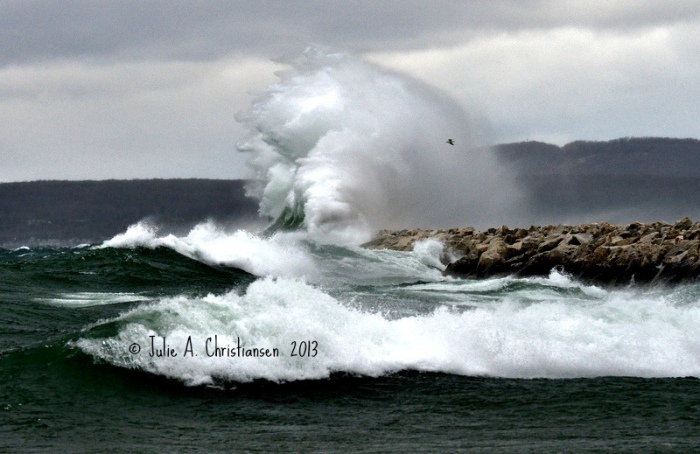Petoskey Breakwall, photo by Julie A. Christiansen
Earlier this week I posted about The Crooked Tree. While August isn’t yet shipwreck season in Michigan, the post reminded me of the 1915 novel by William MacHarg & Edwin Balmer set in the same region called The Indian Drum. The whole book is available online at Project Gutenberg (hooray for free books!). It begins:
Near the northern end of Lake Michigan, where the bluff-bowed ore-carriers and the big, low-lying, wheat-laden steel freighters from Lake Superior push out from the Straits of Mackinac and dispute the right of way, in the island divided channel, with the white-and-gold, electric lighted, wireless equipped passenger steamers bound for Detroit and Buffalo, there is a copse of pine and hemlock back from the shingly beach. From this copse—dark, blue, primeval, silent at most times as when the Great Manitou ruled his inland waters—there comes at time of storm a sound like the booming of an old Indian drum. This drum beat, so the tradition says, whenever the lake took a life; and, as a sign perhaps that it is still the Manitou who rules the waters in spite of all the commerce of the cities, the drum still beats its roll for every ship lost on the lake, one beat for every life.
So—men say—they heard and counted the beatings of the drum to thirty-five upon the hour when, as afterward they learned, the great steel steamer Wenota sank with twenty-four of its crew and eleven passengers; so—men say—they heard the requiem of the five who went down with the schooner Grant; and of the seventeen lost with the Susan Hart; and so of a score of ships more. Once only, it is told, has the drum counted wrong.
At the height of the great storm of December, 1895, the drum beat the roll of a sinking ship. One, two, three—the hearers counted the drum beats, time and again, in their intermitted booming, to twenty-four. They waited, therefore, for report of a ship lost with twenty-four lives; no such news came. The new steel freighter Miwaka, on her maiden trip during the storm with twenty-five—not twenty-four—aboard never made her port; no news was ever heard from her; no wreckage ever was found. On this account, throughout the families whose fathers, brothers, and sons were the officers and crew of the Miwaka, there stirred for a time a desperate belief that one of the men on the Miwaka was saved; that somewhere, somehow, he was alive and might return. The day of the destruction of the Miwaka was fixed as December fifth by the time at which she passed the government lookout at the Straits; the hour was fixed as five o’clock in the morning only by the sounding of the drum.
The region, filled with Indian legend and with memories of wrecks, encourages such beliefs as this. To northward and to westward a half dozen warning lights—Ile-aux-Galets (“Skilligalee” the lake men call it), Waugaushance, Beaver, and Fox Islands—gleam spectrally where the bone-white shingle outcrops above the water, or blur ghostlike in the haze; on the dark knolls topping the glistening sand bluffs to northward, Chippewas and Ottawas, a century and a half ago, quarreled over the prisoners after the massacre at Fort Mackinac; to southward, where other hills frown down upon Little Traverse Bay, the black-robed priests in their chapel chant the same masses their predecessors chanted to the Indians of that time. So, whatever may be the origin of that drum, its meaning is not questioned by the forlorn descendants of those Indians, who now make beadwork and sweet-grass baskets for their summer trade, or by the more credulous of the white fishermen and farmers; men whose word on any other subject would receive unquestioning credence will tell you they have heard the drum.
Read on at Project Gutenberg.
Julie took this shot back in November of 2013. You can view it bigger, see more in her This & That slideshow and also check out this video from the day.
More Michigan shipwreck lore on Michigan in Pictures.


Dramatic shots of my home town. Julie always gets the shot!
LikeLiked by 3 people
I didn’t know you were from Petoskey, Mark. Or did I…?
LikeLiked by 1 person
Hard to say .. but that’s where I grew up, and graduated from PHS. I’ve definitely been on that break wall at times when I should not have been :)
LikeLike
Something about Lk. Superior. Eerily constant and mysterious.
LikeLiked by 2 people
Lake Superior is cool Foghorn – this is Lake Michigan (Little Traverse Bay at Petoskey Harbor to be precise).
LikeLiked by 1 person
I would love to live in Michigan especially the winters. I lived in Fairbanks. AK and even then thought, that place is magic.
LikeLiked by 1 person
I grew up in this town. In winter the bay would regularly freeze over. In fact, Lake Michigan would often freeze out past Beaver Island, and foolhardy snowmobilers would go back and forth. Those freezes are a thing of the past.
LikeLike
Love these kind of shots! I have spent hours watching the ocean and waves breaking over the rocks. There’s something mediative about the ocean.
LikeLiked by 1 person